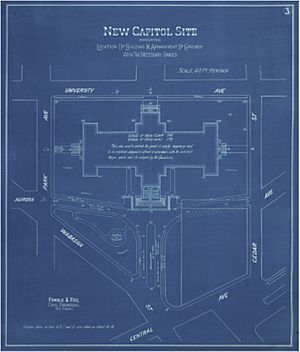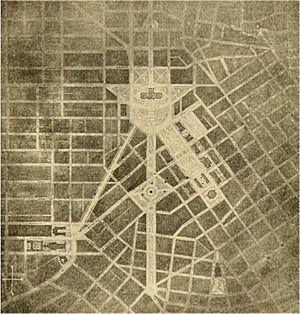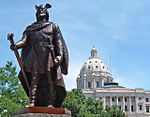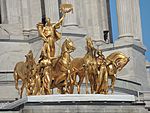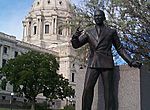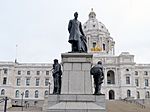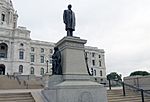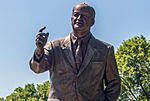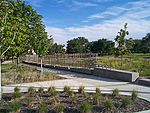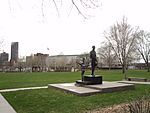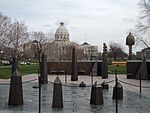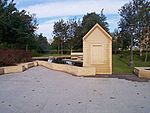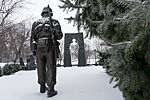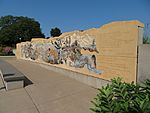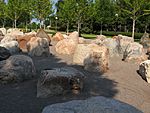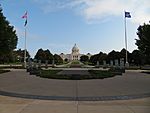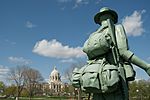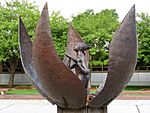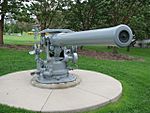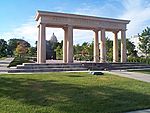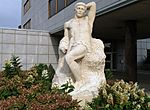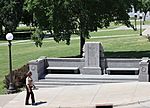Minnesota State Capitol Mall facts for kids
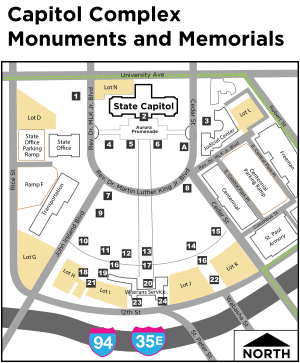
1. Leif Erikson
2. Quadriga: Progress of the State
3. Judicial Plaza
4. Floyd B. Olson – Governor during depression years
5. John Johnson – 1st Governor born in state
6. Knute Nelson: 1st foreign born Governor
7. Hubert H. Humphrey
8. The Women’s Suffrage Memorial Garden
9. Charles Lindbergh: The Boy and the Man
10. Roy Wilkins Memorial
11. Laos Special Forces Memorial
12. MN Vietnam Memorial
13. Court of Honor
14. Korean War Veterans Memorial
15. MN Workers Memorial
16. Military Family Tribute
17. MN World War II Veterans Memorial
18. Fallen Firefighters Memorial
19. Monument to the Living
20. Promise of Youth
21. U.S.S. Ward Gun
22. The Peace Officers Memorial
23. Earthbound
24. Liberty Bell
A. Christopher Columbus Memorial (pedestal)
The Minnesota State Capitol Mall is a large green area in front of the State Capitol building. It covers about 18 acres, which is like 18 football fields! Over many years, statues and special tributes have been added here. People often call it "Minnesota's Front Lawn." It's a place where people gather for all kinds of events. They come to celebrate, have fun, show their support for causes, or even to remember sad times.
A group called the Capitol Area Architectural and Planning Board (CAAPB) takes care of the mall. This group works to keep the Capitol building, its grounds, and nearby areas looking beautiful and important.
Contents
- History of the Capitol Mall
- Monuments and Memorials
- Leif Erikson
- Quadriga "Progress of the State"
- Judicial Center Plaza
- Floyd B. Olson Memorial
- John Johnson Memorial
- Knute Nelson Memorial
- Hubert H. Humphrey Memorial
- Minnesota Woman Suffrage Memorial
- Charles Lindbergh Memorial "The Boy and the Man”
- Roy Wilkins Memorial "Spiral for Justice"
- Special Forces in Laos Memorial
- Minnesota Vietnam Veterans Memorial "Lakefront DMZ"
- Court of Honor
- Minnesota Korean War Veterans Memorial
- Minnesota Workers Memorial Garden
- Military Family Tribute
- Minnesota World War II Veterans Memorial
- Minnesota Fallen Firefighters Memorial
- Monument to the Living
- Promise of Youth
- U.S.S. Ward Gun
- Peace Officers Memorial
- Earthbound Monument
- Liberty Bell
- Christopher Columbus Memorial
History of the Capitol Mall
In 1894, a company named Fowble and Fitz created plans for the area around the new Minnesota State Capitol. At first, not much thought was given to the land around the Capitol. The people planning the building didn't really focus on how the surrounding area would look.
When the Minnesota State Capitol opened in 1905, it didn't have the big open green space we see today. Instead, it looked out over a small patch of grass. The area was surrounded by streets with many shops and homes built between the 1870s and early 1900s.
The architect who designed the Capitol, Cass Gilbert, wanted a grand entrance for his building. He kept pushing for this idea for 30 years! Gilbert's plan was inspired by famous designs like the 1893 Chicago World's Fair and the McMillan Plan for parks in Washington, DC.
However, Minnesota lawmakers didn't want to spend money to buy the land needed for Gilbert's big vision. His ideas were included in larger city plans for St. Paul in 1911 and 1922, but these plans were never officially approved.
Over time, the neighborhood around the State Capitol became older and run-down. In 1936, a magazine even called the area "among the worst in the land." Many ideas for a better front area for the Capitol were suggested. But it wasn't until after World War II that the city and state finally agreed on a plan.
The landscape design firm Morell and Nichols created the new plan. It used some of Gilbert's ideas, like grand tree-lined streets leading to the Capitol. But it removed Gilbert's idea for a south approach. This made it easier for lawmakers to approve because it meant buying less land. The new plan included a walking mall leading from the Capitol steps to a "court of honor."
The state spent $2 million to create the mall. It was designed to make the State Capitol look grand. It also made space for new state buildings that would be built later. The plan also considered a new highway (now Interstate 94) that would go through downtown St. Paul. This highway would require many buildings to be torn down.
After the plan was approved, the state and the City of St. Paul started buying properties. More than 100 homes and buildings were bought and then taken down. This made room for the Capitol Mall and land for state buildings. Within five years, the neighborhood south of the Capitol was completely gone.
Most of the work was finished by 1955. This gave the State Capitol Mall the look it still has today. It provides a beautiful setting for the Minnesota State Capitol.
Monuments and Memorials
Here is a list of the monuments and memorials you can find on and around the State Capitol Mall.
Leif Erikson
Leif Erikson is believed to be the first European to step onto North America (not including Greenland) around 1000 A.D. Thousands of people came to the dedication of this memorial.
- Sculptor: John Karl Daniels
- Dedicated: October 9, 1949
Quadriga "Progress of the State"
The Quadriga is a large, golden sculpture on top of the Minnesota State Capitol's dome. It was created in 1906 by Daniel Chester French and Edward Potter. The charioteer (the person driving the chariot) represents Minnesota's drive for progress. The four horses stand for earth, air, fire, and water. The two women represent industry and agriculture. They hold the reins, showing how people control nature. The pineapples on the chariot wheels are a symbol of welcome. Together, these figures show the future progress of Minnesota.
- Sculptors: Daniel Chester French and Edward Potter
- Created: 1906
Judicial Center Plaza
Judicial Center Plaza is a public area with stones that look like ancient Greek ruins scattered around.
- Sculptor: Richard Fleischner
- Created: 1990
Floyd B. Olson Memorial
Floyd B. Olson was the governor of Minnesota from 1931 to 1936. He was the first governor from the Farmer-Labor Party. Olson worked hard to help people during the Great Depression. He was elected for a third term in 1934. Sadly, he died in 1936 at age 44.
- Sculptor: Carlo Brioschi and Amerigo Brioschi
- Dedicated: 1958 (during Minnesota's 100th birthday celebration)
John Johnson Memorial
John Albert Johnson became governor in 1905. He was the first Minnesota-born governor. He died suddenly in 1909 at age 48 while still in office. In 1908, Johnson was the first Minnesota governor to try to become president, but he did not win the nomination. The bronze pictures on the statue's base show Minnesota's early main industries: farming, iron mining, logging, and manufacturing.
- Sculptor: Andrew O'Connor
- Dedicated: 1912
Knute Nelson Memorial
Knute Nelson was born in Norway in 1843. He was Minnesota's first foreign-born governor. He served in the American Civil War. Nelson was governor from 1893 to 1895. He then became a U.S. Senator and served until he died in 1923. The bronze figures on the base show him as a child with his Norwegian mother and as a soldier.
- Sculptor: John Karl Daniels
- Dedicated: 1928
Hubert H. Humphrey Memorial
Hubert H. Humphrey was the Mayor of Minneapolis from 1945 to 1948. He worked to fight against unfair treatment of people. In 1948, he was elected to the U.S. Senate. He served three terms there. At a big meeting in 1948, his speech about civil rights was very popular. He became Vice-President in 1965 under President Lyndon Johnson. In 1968, he ran for President but lost to Richard Nixon. Humphrey was re-elected to the Senate in 1971 and served until he died in 1978. Near the end of his career, many people in Congress thought he was one of the most effective senators of the past 50 years.
- Sculptors: Jeff Koh Varilla and Anna Koh Varilla
- Site Design: Jeff Martin, DSU
- Dedicated: August 4, 2012
Minnesota Woman Suffrage Memorial
This memorial honors 25 women who were important in the fight for women's right to vote in the United States. It's a garden called "Garden of Time: Landscape of Change." It has signs that describe important events in the women's suffrage movement.
- Sculptor: Raveevarn Choksombatchai and Ralph Nelson
- Landscape Designer: Roger Grothe
- Dedicated: August 26, 2000
Charles Lindbergh Memorial "The Boy and the Man”
This bronze statue honors Charles A. Lindbergh, a famous aviator from Minnesota. He was the first person to fly alone across the Atlantic Ocean without stopping. He flew his plane, the Spirit of St. Louis, from New York to Paris, France. The sculpture shows Lindbergh as a boy dreaming of flying and as a man whose dream came true. While most people liked the statue, some had concerns because of comments Lindbergh made before World War II.
- Sculptor: Paul T. Granlund
- Dedicated: 1985
Roy Wilkins Memorial "Spiral for Justice"
This memorial has 46 parts, representing the 46 years Roy Wilkins led the NAACP. During his time, great progress was made in civil rights in the U.S. The wall in the memorial stands for the barriers created by unfair treatment based on race. The spiral goes up and through these walls, showing progress towards racial equality. An tall stone pillar with an African design honors ancestors.
- Sculptor: Curtis Patterson
- Dedicated: November 1995
Special Forces in Laos Memorial
This memorial honors the brave Hmong and Lao veterans. They served and fought alongside the U.S. in Southeast Asia during the Vietnam War.
- Sculptor: Marjorie Pitz
- Site Design: Kathryn Ryan and Greg Brown
- Dedicated: June 11, 2016
Minnesota Vietnam Veterans Memorial "Lakefront DMZ"
A red granite map of Indochina marks the entrance to this memorial. A winding path leads you as if you are coming home from Southeast Asia. A granite wall has the names of all 1,120 Minnesotans who were killed or went missing in the Vietnam War. The main area has 68,000 granite squares, each representing a Minnesotan who served. 1,120 of these squares are dark green, showing the hometowns of those who died or went missing. A stone house front represents coming home. Pools, streams, and native Minnesota trees add to this feeling.
- Designers: Nina Ackerberg, Stanton Sears, Jake Castillo and Rich Laffin
- Dedicated: September 26, 1992
Court of Honor
Since World War II, the Court of Honor has been a special tribute to veterans. It is a circular area on the mall. The walls of this memorial have bronze plaques that honor soldiers who died in wars the U.S. has fought in.
Minnesota Korean War Veterans Memorial
This memorial features a large bronze statue of a soldier looking for his unit. A granite shape of a soldier represents those missing in action from the Korean War. Columns at the site list the names of the 748 Minnesotans who died in the Korean War.
- Sculptor: Art Norby
- Landscape architects: Bob Kost and Dean Olson
- Dedicated: September 18, 1998
Minnesota Workers Memorial Garden
A stone panel here says: "THIS MEMORIAL IS DEDICATED TO ALL MINNESOTANS THAT HAVE GIVEN THEIR LIVES IN THE WORKPLACE." A mural on the memorial shows workers of all backgrounds in many different jobs. Labor leaders in Minnesota gather here every April 28th to honor workers who died that year from work-related accidents or injuries.
- Mural Design: Craig David
- Sculptor: Mark Wickstrom
- Landscape Architects: Jean Garbarini and Jennifer Germain
- Dedicated: August 3, 2010
- Re-dedicated: 2016
Military Family Tribute
Gold Star Table
The Gold Star Table has five legs that point to the five points of a gold star. Since 1917, the Gold Star has been a symbol to remember someone who died while serving in the military. The table top is smooth and shiny. Light shines through holes to show constellations from the Northern Hemisphere. The North Star is highlighted as a guide home. It also refers to Minnesota's state motto, "L'toile du Nord," which means "Star of the North." This tribute honors Minnesota families who have lost a loved one in military service. The Gold Star Table specifically recognizes the great sacrifice made by Gold Star Families.
- Designer: Theodore Lee
- Fabricator: MG McGrath
- Dedicated: June 13, 2015
Story Stones
There are 87 stones in this memorial, one for each of Minnesota's 87 counties. On these stones are parts of letters sent between soldiers and their families back home. They also show the county of the person who sent or received the letter. The Story Stones show the connections between soldiers serving far away and their loved ones at home. These letters date from the American Civil War to today. For example: "Be a good girl Mary" "Daddy will come home some day again." -1945 Stearns (county).
- Designer: Theodore Lee
- Dedicated: June 13, 2015
Minnesota World War II Veterans Memorial
This memorial has ten glass panels with words and pictures from World War II etched into them. They are in a plaza area at the foot of the mall leading to the Capitol. The glass panels are three feet wide and eight feet tall. They are set on Minnesota granite.
- Designers: Ben Sporer, Todd Hallunes, Andrea Myklebust and Stanton Sears; Landscape Architect: Bryan D. Carlson
- Dedicated: June 2007
Minnesota Fallen Firefighters Memorial
This statue was first at the Minneapolis-Saint Paul International Airport. It was later moved to the Minnesota State Capitol mall. A granite wall lists the names of Minnesota's 791 fire departments. Columns list the names of 217 Minnesota firefighters who died while on duty since 1881. The rusty-looking steel of the columns is meant to look like the oxidation of fire.
- Sculptor: Douglas O. Freeman
- Architect: Leo A Daly
- Engineer: Westwood Professional Services
- Dedicated: September 30, 2012
Monument to the Living
This monument was dedicated ten years before the Vietnam memorial. It was created by a Vietnam veteran using 1,500 hammered pieces of steel. Money for it came mostly from VFW (Veterans of Foreign Wars) groups. The statue is almost 12 feet tall. It shows a 19-year-old soldier in combat gear, asking, "Why do you forget us?"
- Sculptor: Rodger M. Brodin
- Dedicated: May 22, 1982
Promise of Youth
The sculptor, Alonzo Hauser, wanted to show "youth yearning and reaching out to peace and freedom." He said he did not want to "glorify war." This fountain has had some problems and caused some debate. It never worked as it was supposed to. The lily leaves were meant to open and close, but the heavy bronze made it impossible. It is planned to be fixed and included in a new memorial for the Minnesota Medal of Honor.
- Sculptor: Alonzo Hauser
- Dedicated: 1958
U.S.S. Ward Gun
The destroyer U.S.S. Ward was operated by a crew of Minnesota Naval Reservists. It made history on December 7, 1941. It caused the first American-caused casualties in World War II. It sank a Japanese mini-submarine near Pearl Harbor, Hawaii. The U.S. Navy gave this gun to Minnesota in 1958, during the state's 100th birthday celebration.
- Acquired from: U.S.S. Ward Gunship
- Dedicated: May 10, 1958
Peace Officers Memorial
The Peace Officers Memorial honors Minnesota officers who have died while on duty. Inside, a quote on the granite marker reads, "Blessed are the peacemakers for they shall be called the children of God. Matthew 5:9."
- Designers: Fred Richter and Mark Wentzell
- Dedicated: June 1995
Earthbound Monument
The base of this statue has a quote from English poet John Milton: "Earthbound, Made Captive, Yet Deserving Freedom More." This marble sculpture shows a man held by stone. It remembers veterans who served in war.
- Sculptor: John Karl Daniels
- Dedicated: 1956
Liberty Bell
This is one of 53 copies of the Liberty Bell. They were made in 1950 as part of a United States Savings Bonds Drive.
- Dedicated: 1950
Christopher Columbus Memorial
The bronze sculpture of Christopher Columbus was given as a gift in 1931. It was meant to celebrate the achievements of an Italian person during a time when Italian immigrants faced unfair treatment. However, for Native Americans, the memorial promoted ideas that ignored the terrible things done to Native Americans by Columbus. On June 10, 2020, members of the American Indian Movement took down the statue.
- Sculptor: Carlo Brioschi
- Dedicated: October 12, 1931
- Restoration: 1992


